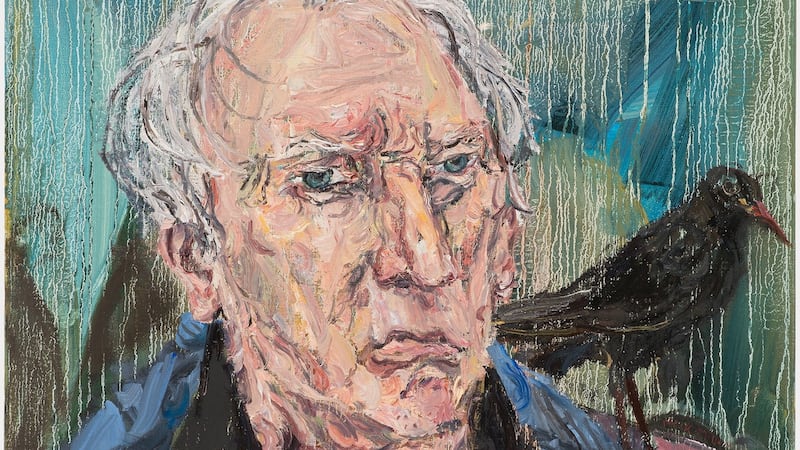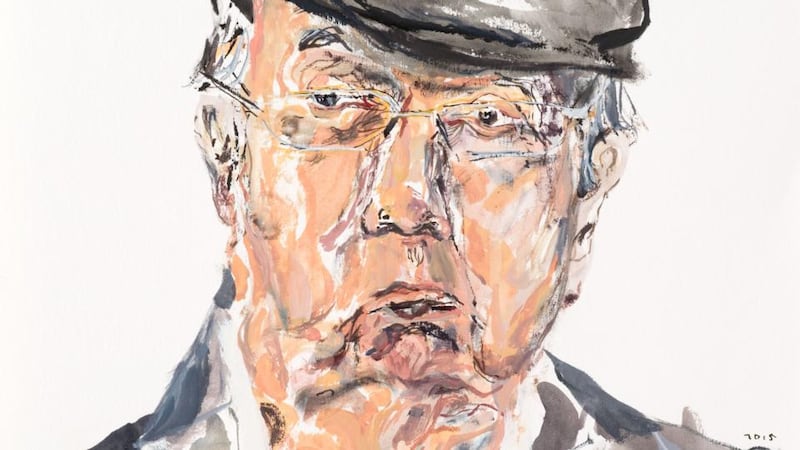Nick Miller and the Studio of Edward McGuire
Irish Museum of Modern Art, Dublin
*****


In 2009, Sally McGuire donated the studio of her late husband, the painter Edward McGuire, to Imma. She died two years later. Her generous donation includes the studio furniture and fittings, painting materials and notebooks, studies, personal possessions, and props used in paintings.
Earlier this year, the artist Nick Miller was invited to respond to the studio contents. He spent time living with them and working among them and now the first floor of the East Ground Galleries is given over to an exhibition featuring much of the studio material, several of McGuire’s paintings and the work Miller made in response.
McGuire was one of the finest portrait painters to have emerged in Ireland. More than that, he was one of the finest Irish artists of the 20th century, with an obsessive, singular vision. He was only in his mid-50s when he died in 1986. McGuire produced iconic portraits of a number of people, especially literary figures, including Seamus Heaney, Anthony Cronin, Paul Durcan, Michael Harnett, Pearse Hutchison, Michael Longley, John Ryan and Francis Stuart (all men, it must be noted; Nuala Mulcahy and Terry Keane were among his rare female sitters).
Besides portraits, he painted chiefly still life, with an emphasis on stuffed birds. He liked to exercise complete pictorial control. You can see part of his studio set-up at Imma: numerous brushes carefully aligned, row on row of precisely arranged pigments, his "colour dictionary". It's much more like a scientific laboratory than the usual, bohemian idea of an artist's studio. McGuire's black-painted room was, as Brian Fallon wrote, "as unwelcoming as a dentist's surgery".
In many ways it’s surprising that McGuire was drawn to depict living human beings, given the iron rigidity of his technique, which broke everything down into a precisely articulated range of colour and tonal values. His exhaustively detailed paintings are anything but photographic. Each is like a textbook exercise in distinguishing painting from photography. Unruly natural forms and textures acquire a stylised regularity in his paintings. To put it bluntly, his figures should come across as robots, and they almost do, but somehow he infuses them with a sense of strange, vital, exciting individuality.
Strangeness is evident in everything he did. His exact naturalism links him artistically to Lucian Freud and Patrick Swift, both of whom he knew. It's said that Swift encouraged him to paint and Freud told him he needed no further formal instruction when he was studying at the Slade. There's another, slightly surreal layer to him, though, which is why comparisons have been made with Rene Magritte. Like Magritte, he takes the ordinary and presents it to us as though we had never noticed its sheer oddness before.
An admirer
Miller has admired McGuire's work since the 1980s, when he linked him to early Freud. Finding himself on McGuire's territory, surrounded by his materials and props, he struggled to find a way into his world. It was, by his account, music that made the difference in the end. McGuire's collection of jazz LPs is included among the studio contents. Miller began to listen to the music – Bill Evans, Erroll Garner, Oscar Peterson and more, but Evans above all – and was suddenly tuned in.
There are three strands to his project. The first is a series of portraits of several of McGuire’s sitters, decades on. One of the best things about the exhibition sounds as if it might have been a real problem: in terms of temperament, it’s hard to think of two artists as dissimilar as McGuire and Miller. McGuire treated figure painting as a species of still life; he joked that he’d like to keep his subjects in the fridge and take them out occasionally to work from them. Whereas for Miller, a painting emerges from a highly charged, unpredictable encounter with a living subject: it’s a record of the experience.
So it's fascinating to see McGuire's original paintings of individuals next to Miller's 2015 depictions. Wanda Ryan is there as a child in a 1963-1966 painting, and she is there now, grown up and vibrant, as Wanda Smolin. Tony Cronin's 1977 likeness is juxtaposed with Miller's fine watercolour study made this year. Cronin reckons McGuire's first portrait in oil was of Garech de Brún, which is on view. It's an amazing piece of work; the youthful-looking subject is surrounded by traditional Irish musical instruments (in reference to his Claddagh Records label) and wearing a thick Aran sweater which, Cronin recalls, was painted "thread by thread" and took several months. Miller's watercolour captures De Brún's mischievous vitality.
Still life is a strong second strand. Some of McGuire’s LP sleeves feature in several of Miller’s, which makes all the more sense as the music is playing throughout the exhibition – a really nice touch, which enhances a visit.
The third strand is more a footnote, but an important one. Miller’s father, Hilton, who died in 2012, was a mathematician who gradually turned to painting. He was a very accomplished landscape painter, and his approach is quite unlike Nick’s but uncannily close to McGuire’s. He too was extremely methodical in his treatment of colour and tone, and a couple of his reference charts are included. It seems like an entirely appropriate touch in an exhibition that is exceptionally warm, generous and inclusive.
- Until April 12th, imma.ie













